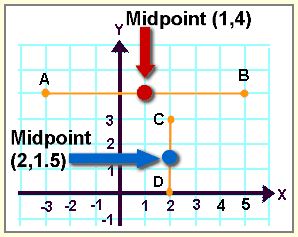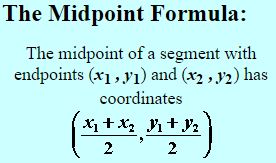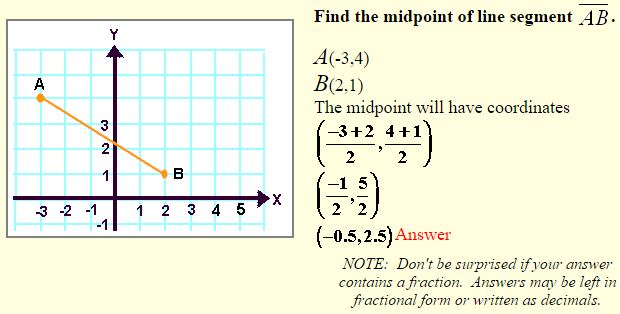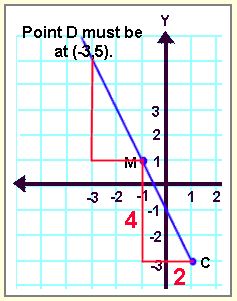Midpoint of a Line Segment
The point halfway between the endpoints of a line segment is called the midpoint. A midpoint divides a line segment into two equal segments.
 By definition, a midpoint of a line segment is the point on that line segment that divides the segment two congruent segments.
By definition, a midpoint of a line segment is the point on that line segment that divides the segment two congruent segments.
In Coordinate Geometry, there are several ways to determine the midpoint of a line segment.
Method 1:
If the line segments are vertical or horizontal, you may find the midpoint by simply dividing the length of the segment by 2 and counting that value from either of the endpoints.
Find the midpoints ¯AB and ¯CD.
 AB is 8 (by counting). The midpoint is 4 units from either endpoint. On the graph, this point is (1,4).
AB is 8 (by counting). The midpoint is 4 units from either endpoint. On the graph, this point is (1,4).
CD is 3 (by counting). The midpoint is 1.5 units from either endpoint. On the graph, this point is (2,1.5)
Method 2:
If the line segments are diagonally positioned, more thought must be paid to the solution. When you are finding the coordinates of the midpoint of a segment, you are actually finding the average (mean) of the x-coordinates and the average (mean) of the y-coordinates.
This concept of finding the average of the coordinates can be written as a formula:
 NOTE: The Midpoint Formula works for all line segments: vertical, horizontal or diagonal.
NOTE: The Midpoint Formula works for all line segments: vertical, horizontal or diagonal.

Consider this “tricky” midpoint problem:
M is the midpoint of ¯CD. The coordinates M(-1,1) and C(1,-3) are given. Find the coordinates of point D.
First, visualize the situation. This will give you an idea of approximately where point D will be located. When you find your answer, be sure it matches with your visualization of where the point should be located.


Other Methods of Solution:
Verbalizing the algebraic solution:
Some students like to do these “tricky” problems by just examining the coordinates and asking themselves the following questions:
“My midpoint’s x-coordinate is -1. What is -1 half of? (Answer -2)
What do I add to my endpoint’s x-coordinate of +1 to get -2? (Answer -3)
This answer must be the x-coordinate of the other endpoint.”
These students are simply verbalizing the algebraic solution.
(They use the same process for the y-coordinate.)
Utilizing the concept of slope and congruent triangles:
A line segment is part of a straight line whose slope (rise/run) remains the same no matter where it is measured. Some students like to look at the rise and run values of the x and y coordinates and utilize these values to find the missing endpoint.
Find the slope between points C and M. This slope has a run of 2 units to the left and a rise of 4 units up. By repeating this slope from point M (move 2 units to the left and 4 units up), you will arrive at the other endpoint.
 By using this slope approach, you are creating two congruent right triangles whose legs are the same lengths. Consequently, their hypotenuses are also the same lengths and DM = MC making M the midpoint of ¯CD.
By using this slope approach, you are creating two congruent right triangles whose legs are the same lengths. Consequently, their hypotenuses are also the same lengths and DM = MC making M the midpoint of ¯CD.
